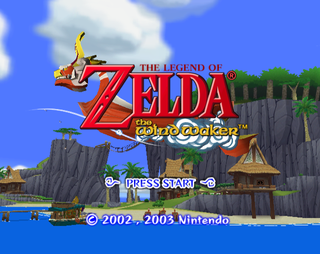The Legend of Zelda: The Wind Waker/fr
| The Legend of Zelda: The Wind Waker |
|---|
|
Also known as: Zelda no Densetsu: Kaze no Takuto (JP)
|
To do:
|
The Legend of Zelda: The Wind Waker présente le pays d'Hyrule après les conséquences du réchauffement climatique.
Contents
Sub-Pages
| Prototype Info (untranslated) |
| Prerelease Info (untranslated) |
Contenu de débogage
Sélection de niveau
| Sélecteur de Niveau Un guide pour le menu de Sélection de Niveau. |
Divers
| Contenu de Débogage Même les jeux ont besoin d'un mannequin de test. |
Contenu Non-vu
| Scènes alternatives Le double de boîtes aux lettres, le double de plaisir! |
| Objets mal Placés Tondeuse dans le vide. |
| Fonctionnalités de Niveau Cachées Les architectes d'Hyrule doivent être biens payés. |
Contenu Inutilisé
Animations
| Animations de Link Inutilisées Continue de nager, continue de nager~ |
| Animations de NPC inutilisées Peut-être que ce Poe est mort d'ennui. |
Cutscenes
| Unused Cutscenes Tetra, tangled in the treetops. |
Maps
| Unused Rooms Test maps out the wazoo. Oh, and some regular unused maps, too. |
Resources
| Unused Items You can't squeeze water from a stone, but can you play tunes with it? |
| Unused Models Saria and psychedelic parrots. |
| Unused Sounds & Sequences Jabun! NOOOOOOO! |
| Unused Text Curiosity killed the cat... |
| Unused Textures Never give Tingle a crayon. |
Data
| Unused Functions The forecast said that there'd be fog... |
Build Date
| To do: "COPYDATED" is part of a debug version that is not the pre-release demo. All files with a "D" at the end of the name are used for this version. The "frameworkD.map" file contains various functions such as the debug camera for example. |
The file COPYDATE contains a date and time for when the game was compiled. The JP Demo Disc 2002 version contains two files: COPYDATE and COPYDATED. The retail Japanese version also contains a copy of the build date in the disc image's internal name field: THE LEGEND OF ZELDA kaze no takuto for Japan 2002 11/27 1:19. The build date file is loaded on boot and used by the unused Map Select and Crash Debugger screens.
| JP Demo Disc Dec 2002 (COPYDATED) |
JP Demo Disc Dec 2002 (COPYDATE) |
JP | US Demo Disc Vol. 9 | JP Demo Disc Jan 2003 | US/KR |
|---|---|---|---|---|---|
02/11/18 22:34:19 |
02/11/19 00:01:49 |
02/11/27 01:19:56 |
02/12/06 16:54:20 |
02/12/11 14:50:37 |
03/02/19 11:43:53 |
| US Demo Disc Vol. 10 | EU/AU Demo Disc Apr 2003 | EU | US ZC Demo | EU ZC Demo | JP ZC Demo |
03/02/27 21:33:17 |
03/02/28 17:45:27 |
03/03/17 19:33:15 |
03/09/08 16:30:56 |
03/09/26 16:45:37 |
03/10/31 17:54:53 |
Developer Credit
// Coded by Kawasedo
Present at offset 0x398389 in the .dol executable. This comment matches a string found in the Game Boy Advance Bootstrap ROM, so it is safe to assume that the .dol contains a copy of the GBA Bootstrap for use with the Tingle Tuner and it is not otherwise related to The Wind Waker.
Regional Differences
| To do: There's a lot more, as discussed here and here plus a note about the translation process by one of the Italian translators. |
Graphical Changes
Some graphics were changed in localization. One known example is the compass when changing the wind's direction, which was redesigned to eliminate the kanji and stylize the existing font. Also, Salvatore's battleship minigame involves slinking ships instead of giant squid in the Japanese version.
Audio Differences
Some minor sound effects are either different (most notably Salvatore's voice acting) or missing in the Japanese release.
Treasure Locations
In an effort to rebalance rewards, a fair amount of the Heart Piece and Treasure Chart locations were moved around, with some minor collectibles shuffled as well. This change is evident right at the beginning of the game, as the chest under Grandma's House contains a Heart Piece in the Japanese version. For America and Europe, this Heart Piece was moved to the bottom of the Savage Labyrinth, which previously held a rather insulting 10 Rupees; the chest under Grandma's House contains 100 Rupees instead. The Wind Waker HD retained most of these changes, but moved a few more items.
In addition, larger Rupee amounts are more rare in the Japanese version. For example, the large pot that can be revealed with the Tingle Tuner on Outset Island was originally a respawning Rupee worth 20; this was changed to a respawning one worth 100. Another instance is the sliding puzzle mini-game, in which the original prize for winning a puzzle was 30 single Rupees in the Japanese version; four blue Rupees were added to make the total 50, and the total given for the 16th completed puzzle was 56 rather than 200.
| Japan | US/Europe |
|---|---|
 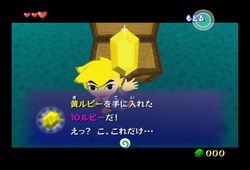 |
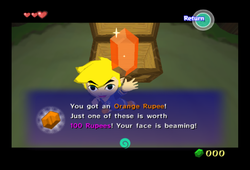 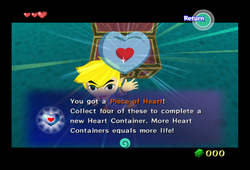 |
As for the Triforce Charts, in the Japanese version, sinking the Golden Ship at Needle Rock does not give you Triforce Chart 5 but rather Treasure Chart 16, which you have to use to get the Triforce Chart as such:
- Sail to Shark Island to get Treasure Chart 28
- Sail to Needle Rock to get Treasure Chart 3
- Sail to Eastern Fairy Island to get Treasure Chart 40
- Finally, sail to Headstone to get Triforce Chart 5
As this sort-of fetch quest was removed, the Treasure Charts were also moved:
- Treasure Chart 16 is now the reward for killing the Wizzrobes on the Seven-Star Isles. In the Japanese version, you'd get a Red Rupee, Golden Feather, and Bokobaba Seed.
- Treasure Chart 28 was moved to the center of Horseshoe Island and replaced the Heart Piece that was there in the Japanese version. This Heart Piece in turn is now the reward for lighting the Windfall lighthouse, instead of just a few rupees.
- Treasure Chart 3 was moved to one of the small islands at Forest Haven and also replaced a Heart Piece. This Heart Piece is now the reward for decorating Windfall with 14 items; in the Japanese version you'd just get 100 rupees, which is totally pointless because the items themselves cost 140 rupees.
- Treasure Chart 40 is now the reward for destroying all the cannons on Southern Fairy Island and replaced a single Golden Feather.
Bombs
Bombs behave a little bit differently between game versions. On the Japanese version hitting the button you have bombs equipped to while holding a bomb will make Link place the bomb down as if you hit R. On the US and European version the button you have bombs equipped to will cause Link to throw a bomb as if you hit A. On the Japanese version you can not equip and unequip Iron Boots while holding a bomb. On the US and European versions you can.
Hyrule Alterations
Among the minor glitch fixes are the invisible walls preventing the player from ever climbing the bridge railing or accessing the fields in Hyrule. But because they were so low on the Japanese version, it was nevertheless possible to access those areas by using the Deku Leaf. More invisible walls were added on top of the already existing walls from the Japanese version.
| Japan | US/Europe |
|---|---|
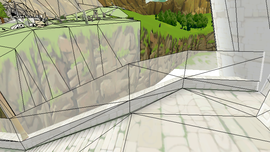 |
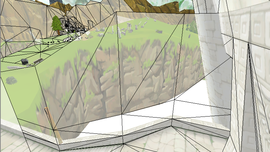 |
| Japan | US/Europe |
|---|---|
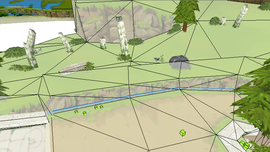 |
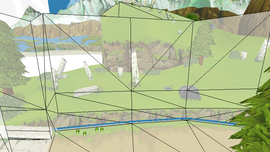 |
| Japan | US/Europe |
|---|---|
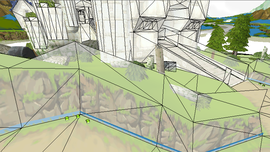 |
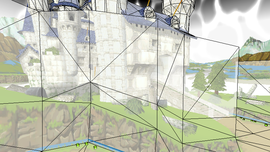 |
In addition to this, the scene in which Link shatters the barrier to the final dungeon happens differently. In the Japanese version, the game fades to black as Link approaches the bouncy shield, and the action occurs automatically. In the international versions, one final "puzzle" was added before the path can be cleared, in which Link must slash at it before the cinema suddenly cuts in.
Tetra's Name
In the Italian release of The Wind Waker, Tetra is called Dazel, an anagram of Zelda.
Molgera Crash
The Japanese and European versions can occasionally crash at the Molgera fight if you pull out his tongue in mid-air during the second phase of the fight and finish him off with a quickspin. It's not exactly known why this happens, but it appears to be related to memory/CPU overload; in any case, this never happens in the American version.
Forsaken Fortress
At the beginning of Link's first visit to Forsaken Fortress, there's a short cutscene where Link is introduced to the Pirate's Charm. In the Japanese version it's possible to simply sidehop over the cutscene trigger, which then leads to an unwinnable situation later in the game because Link never gets his sword back. The cutscene trigger was made larger in the other versions; it's still possible to skip this cutscene, but you pretty much have to do it on purpose.
Fire Mountain and Ice Ring Isle
The international versions of Wind Waker added a check to see if you actually froze/thawed Fire Mountain or Ice Ring Isle when you enter the cave; if not you void out immediately. In the Japanese version you can simply make it to the loading zone to enter the respective caves and skip the whole puzzle and the timer thing.
Pirate Ship
In the Japanese version, the collision for the Pirate Ship is present on the Outset Island map right from the start, even though the graphics are not loaded, so you can use glitches to make it there to get the Spoils Bag right away. The international versions changed this so the collision for the Pirate Ship is only loaded when the actual ship is present (i.e. after the cutscene of Tetra being saved by the pirates).
Bird-Man Contest
In the Japanese version, participating in the Bird-Man Contest loads the wrong version of the overworld, meant for when you visit Forsaken Fortress for the second time. This means that the Skull Hammer will be there for you to pick up, and it's possible from here to revert the overworld further, spawning the Pirate Ship at Outset Island (see above).
Memory Leak
The Japanese version has a memory leak in its actor loading code. When the game loads an actor, it will allocate a certain amount of memory and then attempt to load the actor. If that fails due to an out of memory condition, the code exits without freeing the memory previously allocated. If repeated enough, this can make the memory map fragmented enough that the game will eventually fail to load vital map actors, the most famous of them being the barrier that surrounds Hyrule and prevents players from challenging Ganon early in the game, leading to the "barrier skip". In other versions, the game will first check to see if there actually is enough memory to load the actor in question before allocating any memory.
Nintendo Gallery
Manny's path in the Nintendo Gallery is unfinished in the Japanese and American versions, and he will simply stop and stand in place once he reaches the end of his path. This was fixed in the European version, where the path was finished to create a closed loop. The bug returns in Wind Waker HD, which is based on the American version.
- Pages missing developer references
- Games developed by Nintendo
- Pages missing publisher references
- Games published by Nintendo
- Pages missing date references
- Games with unused animations
- Games with unused areas
- Games with unused code
- Games with unused objects
- Games with unused graphics
- Games with unused models
- Games with unused items
- Games with unused music
- Games with debugging functions
- Games with hidden level selects
- Games with regional differences
- To do
- Legend of Zelda series
Cleanup > Pages missing date references
Cleanup > Pages missing developer references
Cleanup > Pages missing publisher references
Cleanup > To do
Games > Games by content > Games with debugging functions
Games > Games by content > Games with hidden level selects
Games > Games by content > Games with regional differences
Games > Games by content > Games with unused animations
Games > Games by content > Games with unused areas
Games > Games by content > Games with unused code
Games > Games by content > Games with unused graphics
Games > Games by content > Games with unused items
Games > Games by content > Games with unused models
Games > Games by content > Games with unused music
Games > Games by content > Games with unused objects
Games > Games by developer > Games developed by Nintendo
Games > Games by publisher > Games published by Nintendo
Games > Games by series > Legend of Zelda series
